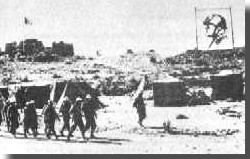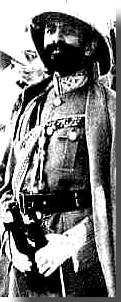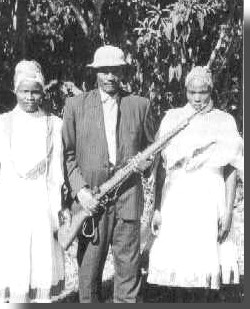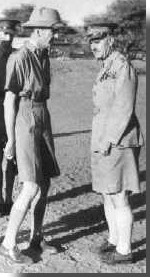MAPS & TERMS
A N e w C a u s e A r i s e s
S e t t i n g
S e t t i n g
S e t t i n g
Background
photo caption
Italian troops in Ethiopia. Invaded in 1935 by a force superior in tactics, firepower, & technology (and using poison gas), in spite of hard fighting the Ethiopian army was decimated & the capital Addis Ababa occupied by Spring, 1936.
Photo courtesy of U.S. Library of Congress


Ethiopia in the summer of 1940 was an occupied Italian colony at war. Italian dictator Benito Mussolini had brought Italy into the war on the side of Germany that June following the fall of France. Italian East Africa (Ethiopia, Eritrea, and Somalia) presented a danger to the British war effort. The Italian position threatened the all-important supply routes to Egypt through the Red Sea. The British also feared a twin offense to squeeze Egypt, one arm from Ethiopia up through the Sudan and another from across Italian Libya. The Italians garrisoned their East African empire with some 280,000 troops, the majority of these forces however, native troops in colonial units officered by Italians. (16 Italian versus 108 colonial infantry & cavalry battalions1) This was larger than the small British forces in both neighboring Sudan and Kenya, and provoked the British into anxiety.
Though Emperor Haile Selassie's Ethiopian armies had been defeated in 1936, an insurgency using guerilla warfare was active in land. These Arbenyotch, or Patriots, were doing their best to ensure a lack physical and psychological safety for the occupiers. Harsh Italian rule had sealed anti-Italian feelings following the conquest. In the northwest regions of Gojjam, Shoa and Tigre, resistance was strong. Italian garrisons were subject to raids and their lines of communication harassed, isolated garrisons were forced to evacuate. Weapons and ammunition stocks were low among the guerillas, but desertions from Italian colonial units and those taken from the battlefield were providing a regular stream. Instead of planned reductions Italian troop strength had to be increased for internal security.
photo caption
Emperor Selassie in 1935. In a year he was forced to flee & plead in vain for international help. King since 1928, crowned Emperor Haile Selassie I in 1930, the royal dynasty believes they are descendants from the Queen of Sheba & King Solomon. He was disposed in 1974 and murdered the next year.
Photo courtesy of
Esther Selassie Antohin & Selassie Family Web
 Yet the resistance was facing daunting problems. In Gojjam province different guerilla groups were refusing to cooperate, preferring to operate in their own known areas & clashing over supplies. Ethiopia was a nation with dozens of different ethnic groups & semi-feudal nobles with different attitudes on Haile Selassie’s rule. To reduce resistance the Italians at times were successful at playing groups against one another, with the western regions not offering much opposition for the Italians. In the Gondor region north of Gojjam, there was little effective resistance with the majority of the ethnic tribal chiefs not engaging in action against the Italians. The composition of the Italian colonial army units being mainly Ethiopian & Eritrean, the war took on a harsh edge, "exceedingly bitter, taking on all the characteristics of a civil war."3 And very little in the form of outside aid to assist in the fighting against the Italians was available.
Yet the resistance was facing daunting problems. In Gojjam province different guerilla groups were refusing to cooperate, preferring to operate in their own known areas & clashing over supplies. Ethiopia was a nation with dozens of different ethnic groups & semi-feudal nobles with different attitudes on Haile Selassie’s rule. To reduce resistance the Italians at times were successful at playing groups against one another, with the western regions not offering much opposition for the Italians. In the Gondor region north of Gojjam, there was little effective resistance with the majority of the ethnic tribal chiefs not engaging in action against the Italians. The composition of the Italian colonial army units being mainly Ethiopian & Eritrean, the war took on a harsh edge, "exceedingly bitter, taking on all the characteristics of a civil war."3 And very little in the form of outside aid to assist in the fighting against the Italians was available.
photo caption
Patriot with family. First Sandford then later Wingate insisted they be refered to as Patriots, instead of rebels. Many swore they would not cut their hair until their nation was liberated, and during the subsequent fighting Allied soldiers would notice Ethiopian fighters due to their long-haired, wild-looking appearance.
Photo courtesy Harold Marcus, A History of Ethiopia, Regents of the U. of California, London, 1996
A Change in Strategy
In spite of British fears, upon the outbreak of war and into its first year the Italian forces in East Africa remained passive. The Italian command was mentally fragile and pessimistic. Pre-occupied with battling the guerillas and fearing a mass uprising, with a considerable portion of their forces committed to internal security they believed the British on the frontiers were stronger than they actually were. They saw their own forces were isolated from outside aid, without a supply stockpile for long-term offensive action, and lacked the resources to overcome their logistic vulnerability. The Italians contented themselves with occupying British Somaliland and launching a few raids against Sudanese border posts. Afterward, the numerically superior Italian forces dug in, hoping for an Axis victory in North Africa.

 Prior to Italian entry into the war, British military intelligence had readied contingency plans for stirring up trouble for Italy in Ethiopia. In September of 1939 General Ironside as commander of the British Army approved a policy to free up the numerically weaker British forces in the Mediterranean region by trying to neutralize Italian East Africa. This meant tying down the Italian forces in Ethiopia using, "Native uprisings encouraged by guerilla tactics by British columns and by Propaganda."4 Arms were gathered in preparation for distribution, resistance leaders were covertly contacted, and volunteers assembled for a clandestine unit to work with and advise the guerillas inside Ethiopia. Led by Colonel Daniel Sandford, a former adviser and friend of the Emperor, upon war the unit was activated & given the name Mission 101 (named after an artillery fuse). London officially recognized the Emperor as an ally, and aid was pledged to rebel commanders. The aid given was small in scale, as the British command concentrated upon trying to build up their weak conventional forces. In August, Colonel Sandford infiltrated into the Gojjam to stimulate the revolt. His success included getting several rival groups to unite. Several supply bases were also set up to intensify resistance efforts, and camel and horse supply convoys out of the Sudan were instituted. But arms were of poor quality and quantity. Limited action by regular British forces was planned to compliment the Patriots to keep the Italians on the defensive.
Prior to Italian entry into the war, British military intelligence had readied contingency plans for stirring up trouble for Italy in Ethiopia. In September of 1939 General Ironside as commander of the British Army approved a policy to free up the numerically weaker British forces in the Mediterranean region by trying to neutralize Italian East Africa. This meant tying down the Italian forces in Ethiopia using, "Native uprisings encouraged by guerilla tactics by British columns and by Propaganda."4 Arms were gathered in preparation for distribution, resistance leaders were covertly contacted, and volunteers assembled for a clandestine unit to work with and advise the guerillas inside Ethiopia. Led by Colonel Daniel Sandford, a former adviser and friend of the Emperor, upon war the unit was activated & given the name Mission 101 (named after an artillery fuse). London officially recognized the Emperor as an ally, and aid was pledged to rebel commanders. The aid given was small in scale, as the British command concentrated upon trying to build up their weak conventional forces. In August, Colonel Sandford infiltrated into the Gojjam to stimulate the revolt. His success included getting several rival groups to unite. Several supply bases were also set up to intensify resistance efforts, and camel and horse supply convoys out of the Sudan were instituted. But arms were of poor quality and quantity. Limited action by regular British forces was planned to compliment the Patriots to keep the Italians on the defensive.
The Commander-in-Chief of Middle East was General Wavell. He was responsible for land operations in the Middle East, Mediterranean and East African regions. Together with Sandford he wanted Emperor Selassie in the war theater, to act as a magnet to rally support and increase resistance. Wavell and his intelligence staff persuaded Prime Minister Churchill to allow the Emperor to fly into the Sudan. Eager to help play his part in what he hoped to be the freeing of his nation, the Emperor arrived in Khartoum in June. Led to believe liberation was immediate, he was disappointed to learn of the miniscule amount of British aid that had arrived, and the restrictions on his movements. Instead of active assistance came local caution and a lack of interest. The civilian colonial government and local military forces in British Sudan opposed any actions that might provoke the Italians into making a military move against a very weakly defended Sudan. The Sudan military leadership under General Platt was pessimistic about the chances of any guerilla action seriously weakening the Italian grip on Ethiopia, and doubted Selassie's abilities. Dejected & questioning his allies' intentions, he began pressing for more to be done and appealed to Churchill and the Secretary of War, Anthony Eden.
photo caption
General Wavell (right) with Secretary of State for War Eden. When he took command of the Middle East on war’s eve, he rejected the purely defensive planning and pushed for a more active defense. In spite of some pre-war planning for an effort to aid the guerillas, Wavell was forced to fight the foreign and colonial ministries on this.
Photo courtesy of the Imperial War Museum, London

 This resulted in a difficult meetings in late October in Khartoum between Eden and Generals Wavell, Platt and Cunningham (commanding forces in Kenya), and regional leaders. Championing Selassie's and Ethiopia's cause, Eden was angry at the lack of aid given to the rebellion so far and wanted successful military action. It was decided to launch an offense aiming to seize part of Italian East Africa & increase the rebellion. Wavell planned a three-pronged offense using reinforcements still arriving. In the north, an Indian infantry division under Platt would move against Eritrea. 2 divisions worth of East African & South African forces under Cunningham would strike in the south from Kenya. Thirdly, assistance to the Patriots would be stepped up and they were assigned the role of tying down and harassing enemy forces in the northwest.
This resulted in a difficult meetings in late October in Khartoum between Eden and Generals Wavell, Platt and Cunningham (commanding forces in Kenya), and regional leaders. Championing Selassie's and Ethiopia's cause, Eden was angry at the lack of aid given to the rebellion so far and wanted successful military action. It was decided to launch an offense aiming to seize part of Italian East Africa & increase the rebellion. Wavell planned a three-pronged offense using reinforcements still arriving. In the north, an Indian infantry division under Platt would move against Eritrea. 2 divisions worth of East African & South African forces under Cunningham would strike in the south from Kenya. Thirdly, assistance to the Patriots would be stepped up and they were assigned the role of tying down and harassing enemy forces in the northwest.
Back in September, participating in a cabinet meeting discussing the Middle East and operations against Italian East Africa, the former Minister of Parliament and now Secretary of State for India Leopold Amery. He suggested that a Major Orde Wingate would be a suitable person to assist and lead these guerillas in Ethiopia. Having become familiar with him, he saw in Wingate, "a much more virile and solidly balanced Lawrence [of Arabia], but with much the same sort of power of inspiring others,"5 Remembering him from Palestine, Wavell agreed to this. A stipulation by Wavell was that Wingate was to be barred from entering Palestine. Wingate arrived in Cairo in October, assigned to the staff branch of military intelligence, MI(R). Arriving initially to Cairo with no official role, and aware of his ban on travel to Palestine, Wingate initially suspected the appointment as means to get him out of the way.
To assist in the goal of aiding the Patriots in their role, Eden and Wavell had decided to create as the main force several battalions of infantry, to be assisted by small detachments of British-led guerilla units. The officer they agreed upon to organize and lead the training of the guerillas, and to advise & liaise between Emperor Selassie and Wavell’s command was Orde Wingate. On November 6th Wingate was dispatched to Khartoum.
1. David Shirreff, Bare Feet And Bandoliers
(London: Radcliffe Press, 1995), 19.
2. Official History of the War in the Middle East quoted in W.E.D. Allen, Guerilla War in Abyssinia (London: Penguin Books, 1943), 30.
3. Shirreff, 17.
4. Simon Anglim, "MI(R), G(R) and British Covert Operations, 1939-42." Intelligence and National Security Journal, Vol.20, No.4 (December, 2005), 640.
5. Christopher Sykes, Orde Wingate
(New York: World Publishing Company, 1959), 230.
6. Director of Military Operations quoted in Anglim, 631.

